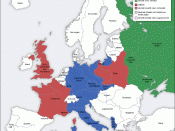One key to the strength of Nazi Germany was their economic prowess. The industrial growth of the German economy under Hitler blossomed from the severe stagflationary economy experienced in the 1920's. In just a few short years Germany went from an economy that had such staggering inflation that it was cheaper to wallpaper one's home with the German Mark than to purchase actual wallpaper. This growth in many ways mirrored the manufacturing growth experienced in the United States in the 1800's. Both countries found capital success in an economy that, in the United States, had a labor shortage, and, in Nazi Germany, had an eventual labor shortage. This allowed for the creation of new and better capital, while contributing greatly to economic growth. The advanced capital found in the United States boosted manufacturing in a labor scarce economy. However, in Nazi Germany the conversion of labor to capital was much different.
Germany, under Hitler, successfully converted labor into capital in a very unique way. The way of life in Nazi Germany, combined with the intimidation of citizens, turned the workers into producing machines that were producing for the good of Germany. Individualization was replaced by conformity in an assembly line fashion. In the U.S., manufacturing workers had the option of leaving the sector in order to find better employment in agriculture, but in Nazi Germany there were no alternatives. A mindset of machine-like production allowed the country to establish itself as a manufacturing giant, which propelled them into the war effort. As the U.S. had a safety valve that allowed manufacturing workers to find employment elsewhere, Nazi Germany was able to massively produce by converting their labor into capital, and this resulted in violent repercussions.





![[Tugboat Escorting Passenger Ship, Nazi Cargo Ship Nearby, Houston Pipe Line Company]](https://s.writework.com/uploads/5/57158/tugboat-escorting-passenger-ship-nazi-cargo-ship-nearby-hou-thumb.jpg)